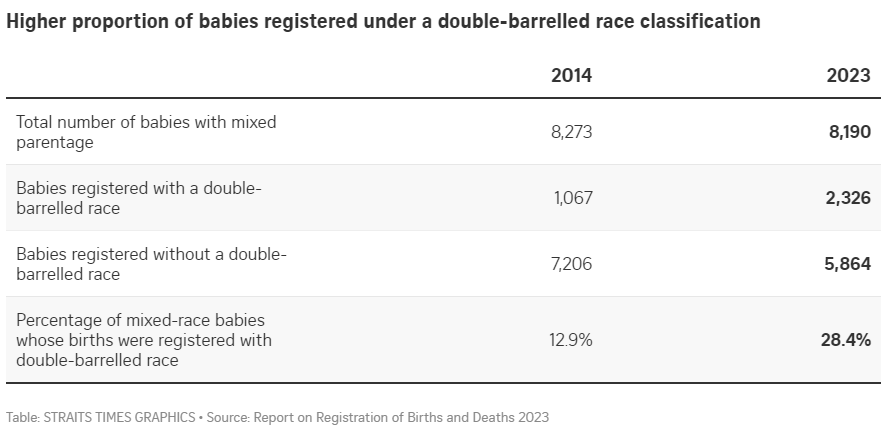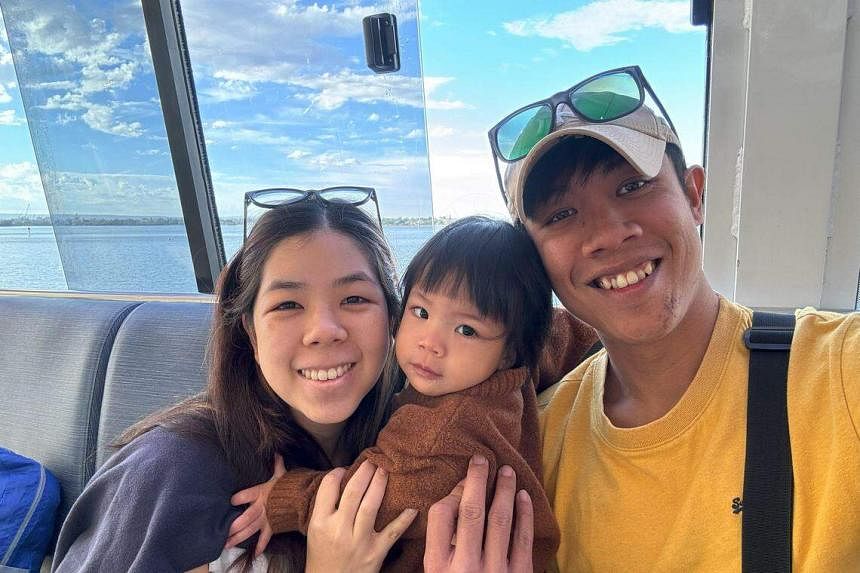'It's only fair': More mixed-race couples in Singapore register double-barrelled race for children


SINGAPORE – For occupational therapist Dawn Lim, 33, it was a “no-brainer” decision to register her children’s race as Indian-Chinese.
Ms Lim, who is Chinese, is married to Mr Balaji Prem Chand, a 35-year-old physiotherapist who is Indian by race. They have three children – Kiaan Lucas Chand, four; Jaanya Elise Chand, two; and Ishaan Evan Chand, who is one month old.
Ms Lim said: “It’s a no-brainer to choose the double-barrelled option so we can reflect both our races. It’s only fair to represent both races, instead of choosing one.”
Like her, more mixed-race couples have chosen to register their children’s birth with a double-barrelled race, such as Chinese-Malay or Malay-Indian.
A total of 2,326 babies of mixed parentage had a double-barrelled race in 2023, more than double the 1,067 such babies in 2014.
Of babies whose parents are of different races, 28.4 per cent of them had a double-barrelled race in 2023, up from 12.9 per cent in 2014.
Such data was presented for the first time in the Report on Registration of Births and Deaths 2023 published by the Immigration and Checkpoints Authority (ICA) on July 11.
An ICA spokesman told The Straits Times the double-barrelled race statistics were included from 2023 onwards to “raise public awareness that parents of different races can register their Singaporean children with a double-barrelled race”.
Since January 2011, inter-ethnic couples can register a double-barrelled race for their Singaporean children during the children’s birth registration. This is on top of the option of choosing to reflect only either the father’s or mother’s race.
The move came amid the growing share of inter-ethnic marriages over the years.
In 2023, 18.1 per cent of all marriages were inter-ethnic unions, up from 17.8 per cent in 2013, and 11.5 per cent in 2003. The data is found in the Statistics on Marriages and Divorces 2023 published by the Department of Statistics on July 15.
Dr Leong Chan-Hoong, head of the Social Cohesion Research Programme at the S. Rajaratnam School of International Studies at Nanyang Technological University, said the rising numbers of babies with a double-barrelled race reflect a growing awareness among couples of this race policy.
People feel prouder of their cultural heritage, and they want to retain both their parents’ racial identities, he added.
Institute of Policy Studies senior research fellow Kalpana Vignehsa noted that in the past, people tended to prize ethnic and racial purity.
“So people who embodied cultural mixing were sometimes met with derisive comments, such as ‘half-caste’, and many people of mixed ethnicity may have felt like they didn’t fully belong anywhere.
“Education, exposure and a growing understanding of the science behind ancestry have changed the cultural context of having a mixed background. As these changes have become more mainstream, there’s been a growing appreciation for the positive side effects of cultural mixing, creating cultural capital for someone who openly declares mixed ancestry,” she said.

From her research, Dr Vignehsa has noticed that individuals of mixed heritage are now more likely to reject the idea that they must choose between their parents’ cultures to fit in.
For the purposes of government policy, such as the assignment of mother tongue classes in schools and the ethnic quota in the Housing Board’s Ethnic Integration Policy, the first component of a double-barrelled race, which is the race that comes before the hyphen, will be used.
There will not be any advantage in terms of policy considerations whether parents register a double-barrelled or a singular race for their child, the ICA has said.
The child’s race is not reflected on his birth certificate, but it will be on the child’s identity card that is issued to him when he turns 15.
Parents who have a Singaporean child under the age of 21 and who was born before Jan 1, 2011, can also ask to change their child’s registered race from a singular one to a double-barrelled one if the eligibility criteria are fulfilled, the ICA spokesman said.
Of the three mixed-race couples interviewed by ST, all chose to state the father’s race before the mother’s for their children’s birth registration.
The main reason is that traditionally and culturally, the father’s ethnicity takes precedence over the mother’s, the mothers said.
Among them is 29-year-old clinical study coordinator Syafiqah Mohammad Shahril, who is married to a Chinese man. They chose to register their nine-month-old son as Chinese-Malay.
On picking the double-barrelled race option for the boy, Ms Syafiqah said: “It’s the most accurate way to represent him, as it reflects both parents’ races.”
Lawyer Celeste Cordeiro, 31, registered her 18-month-old daughter Anastasia as Chinese-Eurasian to remind her child of both of her parents’ heritage. Ms Cordeiro is Eurasian, while her husband, 30-year-old procurement engineer Peter Wong, is Chinese.

She said of her daughter: “She is more Chinese than Eurasian in terms of racial make-up. I’m part Chinese as my mum is Chinese, while my dad is Eurasian, while both of Peter’s parents are Chinese.”
This article was first published in The Straits Times. Permission required for reproduction.